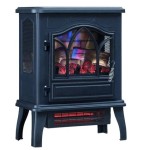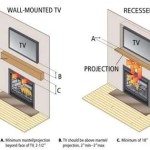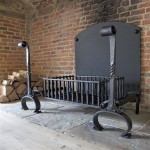Paint for Metal Fireplace Surrounds: A Comprehensive Guide
A metal fireplace surround can significantly enhance the aesthetics of a living space, providing a focal point and adding a touch of elegance. However, over time, the surround can become worn, discolored, or simply outdated. Painting a metal fireplace surround offers an affordable and effective way to revitalize its appearance and integrate it seamlessly into a home's décor. The selection of the appropriate paint and the adherence to proper preparation and application techniques are crucial for achieving a durable and visually appealing finish. This guide provides a comprehensive overview of the factors to consider when painting a metal fireplace surround.
Understanding the Challenges of Painting Metal
Painting metal surfaces presents unique challenges compared to painting wood or drywall. Metal is non-porous, meaning paint doesn't easily adhere. This can lead to chipping, peeling, and rusting if the surface is not properly prepared and the correct type of paint is not used. Furthermore, the high temperatures that a fireplace surround can reach require paints formulated to withstand heat without breaking down or emitting harmful fumes. Understanding these challenges is the first step in ensuring a successful painting project.
One primary concern is corrosion. Untreated metal is susceptible to rust, which can undermine the integrity of the paint job and eventually damage the surround itself. Proper surface preparation, including the removal of existing rust and the application of a rust-inhibiting primer, is essential to prevent future corrosion. Adhesion is another critical factor. The smooth, non-porous nature of metal means that paint requires a surface it can grip onto. Etching the surface slightly, either chemically or mechanically, can significantly improve paint adhesion.
Heat resistance is perhaps the most unique challenge when painting a fireplace surround. Standard paints are not formulated to withstand the high temperatures that a fireplace can generate. Using the wrong type of paint can result in blistering, cracking, discoloration, and the release of potentially hazardous volatile organic compounds (VOCs). Therefore, selecting a paint specifically designed for high-heat applications is paramount.
Selecting the Right Type of Paint
The choice of paint is arguably the most crucial aspect of painting a metal fireplace surround. Not all paints are created equal, and using the wrong type can lead to unsatisfactory results and potential safety hazards. High-heat paints are specifically formulated to withstand elevated temperatures without breaking down, discoloring, or releasing harmful fumes. These paints typically come in spray form, which allows for even application and prevents brushstrokes on the smooth metal surface.
High-heat paints are often classified by their temperature resistance, typically ranging from 500°F to 2000°F (260°C to 1093°C). For a fireplace surround, a paint with a temperature resistance of at least 1200°F (649°C) is generally recommended. This provides a safety margin to account for variations in fireplace usage and heat output. It's crucial to consult the manufacturer's specifications to ensure the paint is suitable for the intended application.
Several types of high-heat paints are available, each with its own characteristics and advantages. Some common options include: *
Silicone-based paints:
These paints offer excellent heat resistance and flexibility, making them ideal for surfaces that expand and contract with temperature changes. *Epoxy-based paints:
Known for their durability and resistance to chemicals, epoxy-based paints provide a tough, long-lasting finish. However, they may not be as flexible as silicone-based paints. *Ceramic-based paints:
These paints offer the highest level of heat resistance and are often used in industrial applications. While they can be more expensive, they provide superior protection and longevity. When selecting a paint, consider the desired finish (matte, satin, or gloss), the color options available, and the ease of application. Also, pay attention to the paint's drying time and curing requirements, as some high-heat paints require a specific curing process to achieve their full heat resistance.In addition to the high-heat paint, selecting a suitable primer is essential. A rust-inhibiting primer will help prevent corrosion and provide a better surface for the paint to adhere to. Choose a primer that is compatible with the chosen high-heat paint and formulated for use on metal surfaces.
Preparing the Metal Surface for Painting
Proper surface preparation is paramount for achieving a long-lasting and aesthetically pleasing paint job. This involves cleaning the surface, removing any existing rust or loose paint, and creating a slightly rough texture to promote paint adhesion. Neglecting surface preparation can lead to premature paint failure, regardless of the quality of the paint used.
The first step is to thoroughly clean the metal surface. Use a degreaser or a strong detergent to remove any dirt, grease, or grime. Rinse the surface thoroughly with clean water and allow it to dry completely. If there is any existing rust, it needs to be removed before painting. This can be accomplished using a wire brush, sandpaper, or a chemical rust remover. For heavy rust, a power tool such as an angle grinder with a wire wheel may be necessary.
Once the rust has been removed, sand the entire surface with medium-grit sandpaper (around 120-180 grit). This will create a slightly rough texture that will help the primer and paint adhere better. After sanding, wipe the surface down with a tack cloth or a clean, damp cloth to remove any sanding dust. It's critical to ensure the surface is completely clean and dry before proceeding to the next step.
If the metal surface is very smooth, consider using a chemical etching primer. This type of primer contains phosphoric acid, which etches the metal surface, creating microscopic grooves that provide a strong bond for the paint. Follow the manufacturer's instructions carefully when using a chemical etching primer, as it can be corrosive.
Mask off any areas that you don't want to paint, such as the surrounding wall or the firebox opening. Use painter's tape and masking paper or plastic sheeting to protect these areas. Take your time and ensure the masking is done correctly to prevent overspray and ensure clean lines.
Applying the Paint and Achieving a Professional Finish
With the surface properly prepared and the correct paint and primer selected, the final step is to apply the paint. This requires careful attention to detail and the use of proper techniques to achieve a smooth, even, and durable finish. Following the manufacturer's instructions for the paint and primer is crucial for optimal results.
Before applying the primer, shake the can thoroughly for at least two minutes to ensure the paint is properly mixed. Hold the can about 10-12 inches from the surface and apply a thin, even coat using a smooth, sweeping motion. Avoid spraying too much paint in one area, as this can lead to drips and runs. Allow the primer to dry completely according to the manufacturer's instructions before proceeding to the next step. This may take several hours or even overnight.
Once the primer is dry, inspect the surface for any imperfections, such as drips, runs, or uneven areas. If necessary, lightly sand these areas with fine-grit sandpaper (around 220-320 grit) to smooth them out. Wipe the surface down with a tack cloth to remove any sanding dust.
Apply the high-heat paint in the same manner as the primer, using thin, even coats. Multiple thin coats are always better than one thick coat, as they are less likely to drip or run and will result in a more durable finish. Allow each coat to dry completely before applying the next one. The number of coats required will depend on the color and opacity of the paint, but typically two to three coats are sufficient.
After the final coat of paint has dried, carefully remove the masking tape and paper. Inspect the painted surface for any imperfections, such as overspray or uneven areas. If necessary, touch up these areas with a small brush. Allow the paint to cure completely according to the manufacturer's instructions before using the fireplace. This may take several days or even weeks, depending on the type of paint used.
Proper ventilation is essential when painting, especially when using spray paint. Work in a well-ventilated area or wear a respirator to protect yourself from inhaling harmful fumes. Take precautions to protect the surrounding area from overspray, as spray paint can travel a considerable distance.
By carefully selecting the right paint, properly preparing the surface, and applying the paint using proper techniques, a metal fireplace surround can be transformed into a beautiful and durable focal point. With proper care and maintenance, the painted finish can last for many years, enhancing the enjoyment of the fireplace.

How To Paint Metal Fireplace Surround Four Generations One Roof

How To Paint Metal Fireplace Surround Mantel Designs Decor Design

How To Spray Paint A Brass Fireplace Insert Erfly House

How To Spray Paint A Brass Fireplace Insert Erfly House

How To Paint Metal Fireplace Surround Four Generations One Roof

Fireplace Door Update With Spray Paint Roots Wings Furniture Llc

How To Paint A Brass Fireplace Screen Addicted 2 Decorating

Use Fireplace Paint To Update Old Hardware For A Makeover

How To Spray Paint A Brass Fireplace Insert Erfly House

Restoring An Iron Fireplace To Strip Or Paint Mr Victorian
Related Posts








